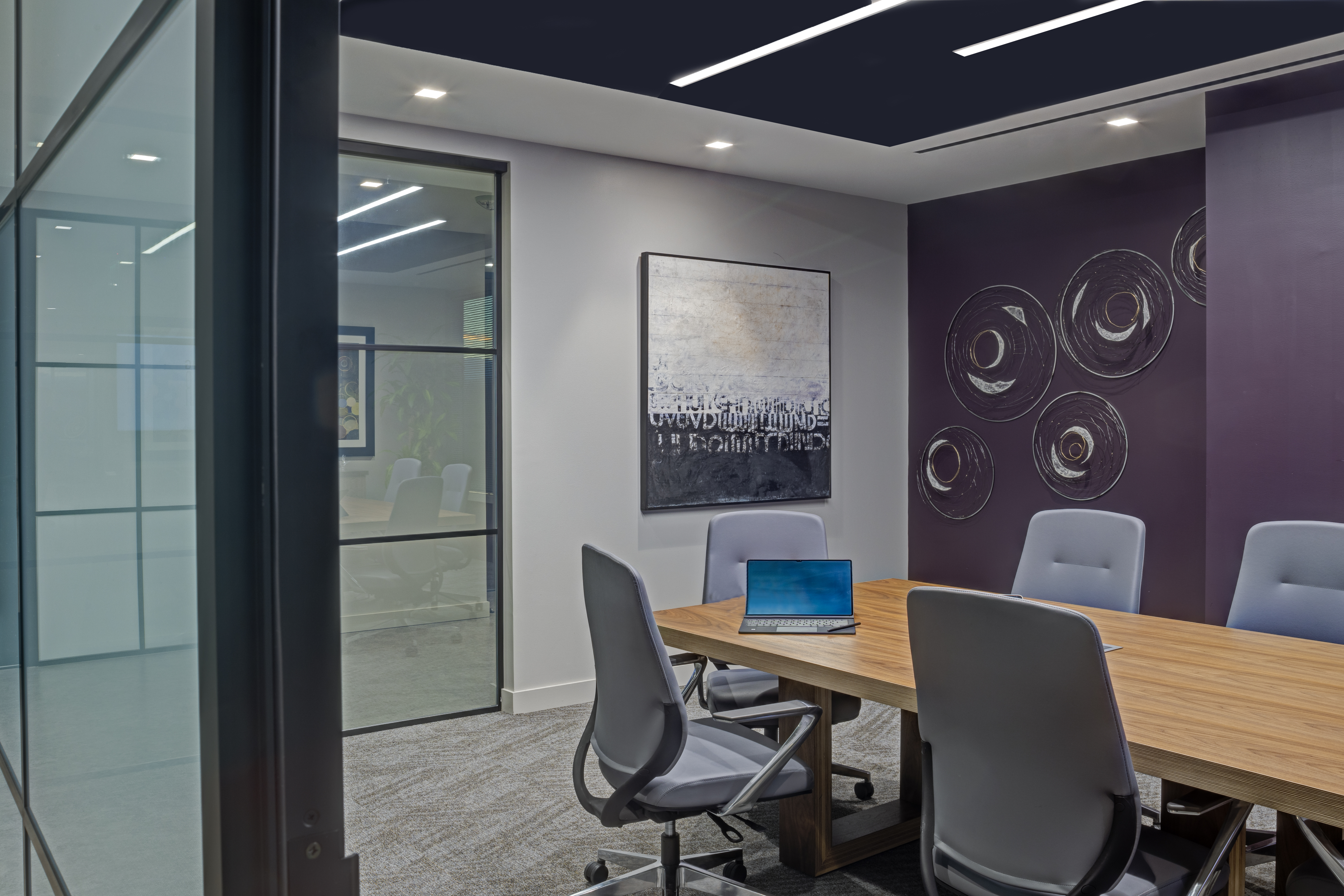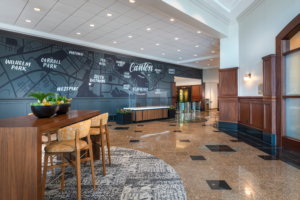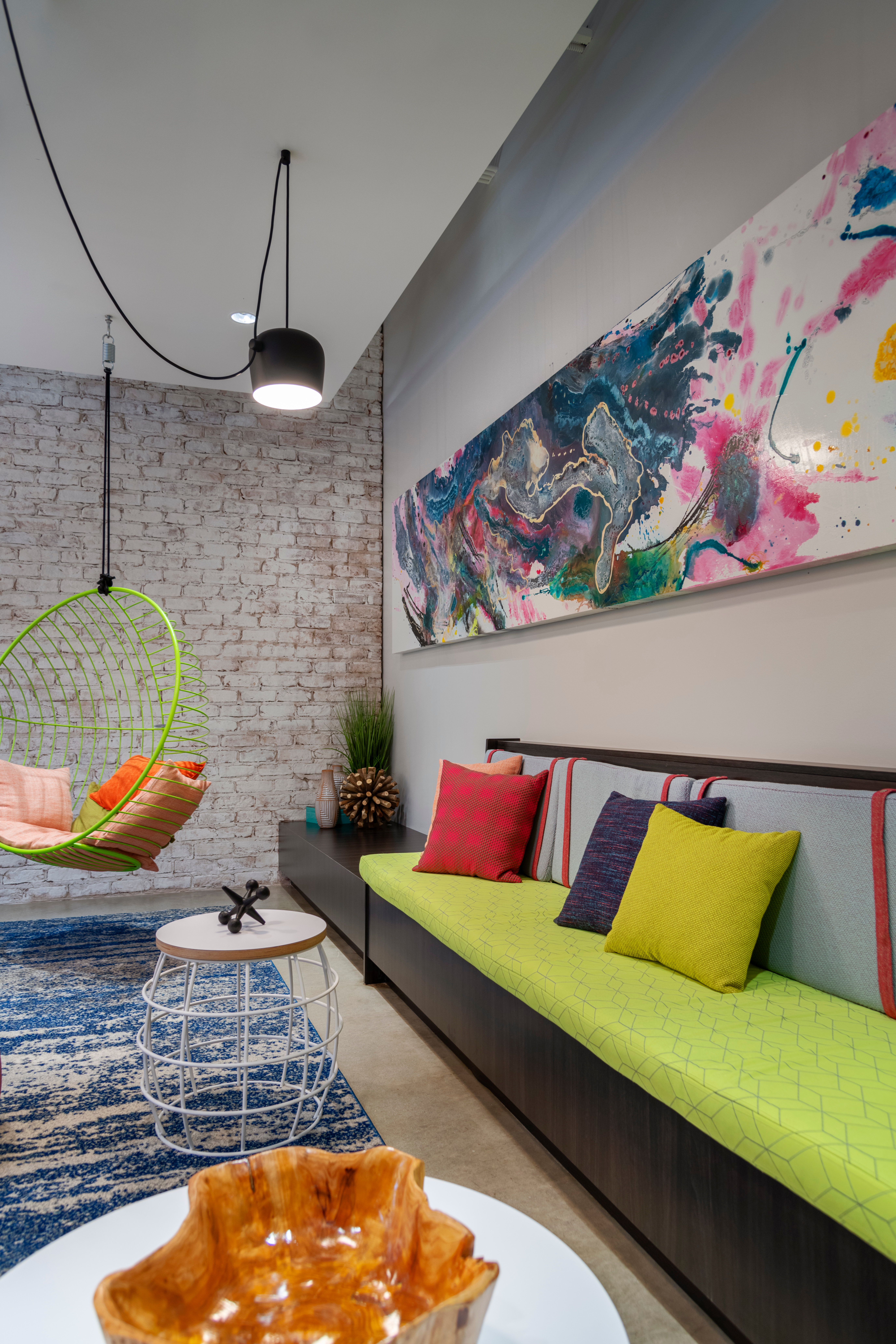From vibrant abstracts and minimalist landscapes to custom-made sculptures, digital displays, graffiti walls, motivational phrases and manipulated drone imagery, art is becoming a more prominent part of the workplace.
In an era when employers are struggling to entice workers back to offices and building owners are searching for ways to attract tenants, it’s an understandable trend.
“Art used to be an afterthought,” said Alex Kramer, Principal Officer with Arris, a Design Studio. “Now it is being thought of early in the design process because companies are trying to attract and retain employees, and they are trying to communicate their culture.”

Law firms are curating art collections for their offices. Photo courtesy of Arris, a Design Studio.
As Gordon Feinblatt LLC prepared to move to its new headquarters in Harbor East, the law firm engaged Design Collective to design the space and the Baltimore Office of Promotion and the Arts (BOPA) to curate a collection of local and thoughtful art.
Rather than hanging innocuous pictures on their walls, “they picked really challenging artwork,” said Lou Joseph, BOPA’s Prize and Competition Manager.
The 45 pieces from 17 local artists included artwork that depicted Latino history, explored environmental issues, presented unconventional abstract compositions or otherwise reflected elements of company culture.
“They were looking at this move as a pivot point for their organization. They called it Gordon Feinblatt 2.0,” Joseph said. “They were thinking about the culture of their company and making substantial investments in diversity, equity and inclusion within their organization. In keeping with their values, they felt they should support a diversity of Baltimore artists.”
Kuehne+Nagel — a worldwide sea, air and land logistics company — also placed heightened priority on art as it opened or renovated its offices. The company contracted Arris to design each branch to reflect both company culture and local culture.

Art is no longer just a picture in a frame. Wall murals, sculptures, digital displays and other art forms are becoming more common in commercial spaces. Photo courtesy of COPT.
In Baltimore, the design included etchings of the skyline, Camden Yards and an oriole, as well as a large graphic of jockeys riding horses in the Preakness and accents in Ravens colors, said Mallika Prasad, Associate of Interior Design at Arris.
As in other branches, the artwork also included motivational phrases, a mural showing the company’s history, tributes to former employees and artwork highlighting its commitment to sustainability. One wall of the Jersey City office featured a large art installation made from twine. Several flatscreens mounted on it displayed imagery and information about the company’s sustainability initiatives.
“For corporations, art is not just pictures in frames on walls anymore,” Kramer said. “Sometimes, the wall is the art and it is covered in big murals, big photographs, motivational phrases or graphic art. Elements within the space — like a custom light fixture or piece of furniture — become the art. Companies use elements of the art — certain colors or graphics — in signage and wayfinding and to give each floor a distinct identity… It’s amazing the thought that goes into creating a building’s identity and setting a tone for that building.”
Some employers and property owners insist that investment helps attract employees to offices and tenants to office buildings.

COPT has commissioned Baltimore artist Kelly Walker to create unique art for several of its properties. Photo courtesy of COPT.
“Anyone can work from home and get comfortable within their four walls,” said Nicole Moore, Director of Design for Corporate Office Properties Trust (COPT). “To draw people back, you want them to feel inspired by the office. Custom art pieces can create that drive and inspiration. It doesn’t feel like a plain office or your home. You feel the energy of being in a public space and you feel more creative immersing yourself in that environment.”
COPT has engaged Baltimore artist Kelly Walker to create unique art for several of its properties, including large wall graphics around an elevator lobby in Canton Crossing and graffiti-style art for CIRQL in Columbia.
“We like the energy her art brings to a space,” Moore said.
Commissioning an artist often costs less than designing and producing custom graphics with marketing and sign companies, she said, and can deliver bigger impact.
“There is more heart and soul that goes into a hand-painted piece,” Moore said. “When you look at a rendering of the planned art piece, you think that’s a really cool design. But when the artist gets in there and starts applying their unique style and brush strokes and texture, that’s what makes the piece sparkle and creates a wow effect.”
Custom art and custom woodworking has so impressed tenants of some COPT buildings that they have expanded that artwork into their own spaces.
Custom art, Moore added, also helps COPT with leasing. COPT includes planned art in the building renderings used for pre-leasing efforts.
“It creates wow moments when you look at those renderings and realize the space is going to feel special and unique. It is impactful,” she said. “I think it leaves a lasting memory when tenants are looking at several buildings. Hopefully, it differentiates our building from some others.”